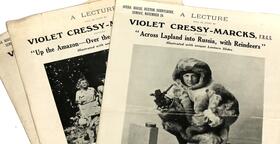Family Legacies
Family Legacies
What impact does provenance have on value? The vast majority of customers who seek our advice come to us following an inheritance or are downsizing and would like to see if items they have been left by previous generations are worth selling. Sometimes it is not only the objects which make up our valuations, but the accompanying ‘provenance’ or history of how these items have travelled through time and who they have been owned by along the way.
A recent consignment from the deceased estate of Jill Rutley is one such example of how seemingly completely unrelated items can hold one tenuous family connection. Jill Rutley was a fascinating character, descended from Crabtree & Co Ltd, engineers and shipbuilders in Great Yarmouth. She attended Cheltenham Ladies College, learned to fly planes, fenced and even met the Queen! A true female trailblazer defying conventions of how a woman should behave in the mid-1900’s. When she recently passed away she bequeathed all of her house and contents to charity and it has been TW Gaze’s honour to be entrusted with cataloguing and selling the estate.
The items are wide ranging from paintings to wine, jewellery to books, but who are the ancestors behind the objects?
Violet Cressy-Marcks
An early 20thC English female explorer, her maiden name was Violet Rutley (Aunt to Jill) Applauded and celebrated for her trailblazing adventures across the globe, she travelled to every country in the world. This from a woman who had been born in 1885, thirty-three years before women were given the vote. The art market is particularly interested in these key historical figures, people who subverted societies expectations, cultures that was destroyed during colonialism and history associated with people of colour.
The books, ephemera and photographs that belonged to Violet are due to be entered into our next book sale on the 5th September. Amongst this treasure trove of items are photographic Christmas cards from across the globe; Ethiopia, China and Tibet. Newspaper clippings (hilariously) contrasting in their content, one headline proclaiming “Woman explorer to settle down- family life better than Wanderlust” following her marriage whilst a later editorial details her adventures in Lapland and being chased by hungry wolves! A catalogue for a charity auction of her collection details delights such as “Violet Cressy-Marcks tent” together with items collected from around the world. More poignant ephemera includes a printed sympathy card for her son William Roy Cressy-Marcks who was killed at the age of 23 during WWII and Violet’s own order of service from her funeral in 1970.
Crabtree & Co Ltd
Jill’s mother Lilian Rutley nee Crabtree was the daughter of a Norfolk engineering empire. They were responsible for the movement of the Winter Gardens to Great Yarmouth in 1904. A gold brooch appearing in the next Jewellery sale features an anchor to the front and an inscription to the back ‘Essex County launched by Lilian Crabtree March 5th ’08.’ A wonderful memento to capture a privileged experience, it is often the backstories to objects that make them engaging and pique the interest of collector’s especially if there is a connection to local history.
And finally, an interesting anomaly….
It is the exception, not the rule to have an object with provenance. In the majority of cases we will never know who owned the item or whence it came. This is true with the following object from Jill Rutley’s collection, an Aboriginal painting by Ewald Namatjira, whose father Albert Namatjira was the founding member of the Hermannsberg School of art.
During colonialism missionaries often utilized indigenous people’s artic skills to justify their humanity to colonial powers, this can be seen in many instances from the renaissance period onwards when there was a global expansion in European territories. This was true of the Hermannsberg Lutheran Mission who converted Albert’s parents, Ewald’s grandparents, to Christianity. He learnt to paint whilst living in the mission and went on to become the founder of a movement that led to the acceptance and appreciation of Aboriginal artists. When Albert and Ewald Namatjira painted, they painted in a ‘westernised’ style depicting romanticized views of the rugged terrain of their beloved homeland. Testament to changing tastes (and a more educated audience), artworks by Aboriginal artists which can sell in the millions now depict traditional styles of artwork which are ground in their cultural heritage and reflect historic Aboriginal techniques.
Ewald was the third of five sons and overcame losing an eye in a gun accident to excel in his painting career. Jill’s painting (which will feature in our Special Sale on the 17 August) depicts rugged Australian landscape with a trademark tree in the foreground allowing a deeper perspective of the valley and mountains in the background. The evocative burnt colours are a refreshing contrast to the lush green pictured in European paintings and allure to a dry and hot landscape that transport you to a rural Australia.
As described, this consignment will feature in sales in August and September at the TW Gaze Auction Rooms in Diss, please check with the website for details of dates and viewing times. www.twgaze.co.uk



